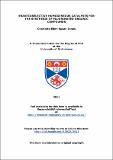Files in this item
Enantioselective homogeneous catalysts for the synthesis of fluorinated organic compounds
Item metadata
| dc.contributor.advisor | Clarke, Matt | |
| dc.contributor.author | Jones, Charlotte E. S. | |
| dc.coverage.spatial | 229 | en_US |
| dc.date.accessioned | 2012-05-23T09:35:51Z | |
| dc.date.available | 2012-05-23T09:35:51Z | |
| dc.date.issued | 2011-06 | |
| dc.identifier | uk.bl.ethos.552706 | |
| dc.identifier.uri | https://hdl.handle.net/10023/2611 | |
| dc.description.abstract | This thesis is divided into three main results chapters that reflect the path my research took. In the first results chapter, the first organocatalyst for the carbonyl-ene reaction was discovered and found to give high conversion using 1,3-bis(3,5-bis(trifluoromethyl)phenyl)thiourea. Various carbonyl and alkene precursors were examined in the ene reaction in both catalysed and uncatalysed reactions. It was found that ene reactions using fluoral and ethyl trifluoropyruvate give higher rates of reaction when compared to other carbonyl compounds. A novel enantiopure thiourea was synthesised and the ene reaction was catalysed enantioselectively to 33% e.e. In an attempt to catalyse the reaction to a further extent a new thiourea bonded to a P(=S)R2 group was developed. However, the intramolecular hydrogen bonding of this catalyst was thought to be so strong that this it did not catalyse the reaction. The synthesis of a chiral phosphoric acid was achieved but this was an unsuccessful catalyst in the ene reaction. Two component achiral thiourea and chiral acids were also examined in the ene and Mannich-type reaction. The new easily synthesised thiourea for this reaction has an interesting intermolecular hydrogen bonding coordination in the solid state. Asymmetric fluorination of ketoesters using palladium is a dynamic kinetic resolution. In the 2nd chapter cationic palladium complexes were synthesised and used to determine the optimum parameters for bidentate ligands in this reaction. Four carbon chain phosphines were found to give the highest conversion for this reaction among those ligands tested such as 1,4-bisdiphenylphosphinobutane (bite angle 99º). A new bis-phosphinous amide chiral ligand was developed with a bite angle of 96.7º. The dichloropalladium complex of this phosphine was isolated and structurally characterised. The use of the palladium complex in asymmetric fluorination was attempted however this was found to be unsuccessful. Mechanistic studies reveal that the formation of the desired cationic catalyst did not occur under conditions shown to work well for other palladium phosphine complexes. The ligand was investigated further in hydrogenation reactions. The phosphinous amide was protected as its borane and was used in the rhodium catalysed hydrogenation of alkenes to give high conversion and up to 93% e.e. The borane protected phosphinous amide was also found to catalyse the hydrogenation of acetophenone using copper complexes with up to 84% e.e for the hydrogenation of acetophenone, although conversion was quite low. | en_US |
| dc.language.iso | en | en_US |
| dc.publisher | University of St Andrews | |
| dc.subject | Asymmetric catalysis | en_US |
| dc.subject | Organocatalysis | en_US |
| dc.subject | Ene reaction | en_US |
| dc.subject | Fluorination | en_US |
| dc.subject | Hydrogenation | en_US |
| dc.subject | Thiourea | en_US |
| dc.subject.lcc | QD505.J7 | |
| dc.subject.lcsh | Asymmetric synthesis | en_US |
| dc.subject.lcsh | Catalysis | en_US |
| dc.subject.lcsh | Enantioselective catalysis | en_US |
| dc.subject.lcsh | Organofluorine compounds--Synthesis | en_US |
| dc.subject.lcsh | Hydrogenation | en_US |
| dc.subject.lcsh | Thiourea | en_US |
| dc.title | Enantioselective homogeneous catalysts for the synthesis of fluorinated organic compounds | en_US |
| dc.type | Thesis | en_US |
| dc.type.qualificationlevel | Doctoral | en_US |
| dc.type.qualificationname | PhD Doctor of Philosophy | en_US |
| dc.publisher.institution | The University of St Andrews | en_US |
This item appears in the following Collection(s)
Items in the St Andrews Research Repository are protected by copyright, with all rights reserved, unless otherwise indicated.

